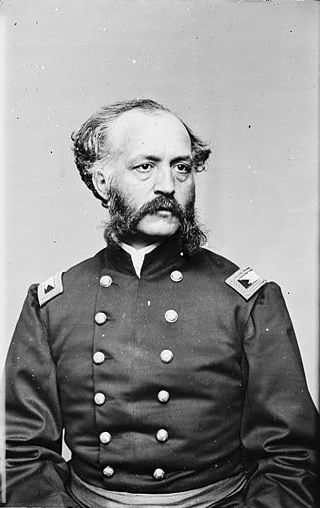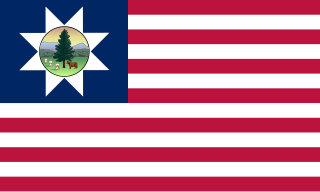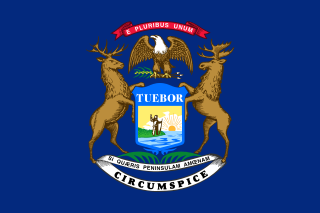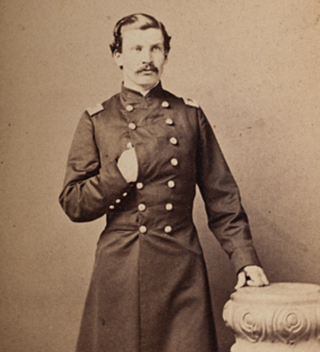
XXII Corps was a corps in the Union Army during the American Civil War. It was created on February 2, 1863, to consist of all troops garrisoned in Washington, D.C., and included three infantry divisions and one of cavalry. Many of its units were transferred to the Army of the Potomac during Grant's Overland Campaign.

Hiram Berdan was an American engineer, inventor, military officer, marksman, and guiding force behind and commanding colonel of the United States Volunteer Sharpshooter Regiments during the American Civil War. He was the inventor of the Berdan rifle, the Berdan centerfire primer and other weapons and accessories.

During the American Civil War, the State of Vermont gave strong support to the Union war effort, raising troops and money. According to Rachel Cree Sherman:
By the spring of 1865 Vermont was devastated, having sent one tenth of its entire population to war, with a loss of over 5,000 lives to battle, wounds, and disease. The state had dedicated nearly $10 million to support the conflict, half of that amount offered up by towns with no expectation of recompense.

The 2nd Vermont Infantry Regiment was a three years' infantry regiment in the Union Army during the American Civil War. It served in the eastern theater, predominantly in the VI Corps, Army of the Potomac, from June 1861 to July 1865. It was a member of the famous Vermont Brigade.
The 10th Vermont Infantry Regiment was an infantry regiment in the Union Army during the American Civil War.
The 116th Pennsylvania Infantry was a volunteer infantry regiment in the Union Army during the American Civil War. It formed a part of the Irish Brigade.

Hiram Gregory Berry was an American politician and general in the Army of the Potomac during the American Civil War.

The 5th Michigan Infantry Regiment was an infantry regiment from Michigan that served in the Union Army during the American Civil War. The regiment was mustered into federal service in August 1861 and served in the Eastern Theater. It fought in all the major battles of the Army of the Potomac, including Seven Pines, the Seven Days Battles, Second Bull Run, Chantilly, Antietam, Fredericksburg, Chancellorsville, Gettysburg, the Wilderness, Spotsylvania, Cold Harbor, Petersburg, and Appomattox. The regiment was mustered out in June 1865.

The State of Michigan raised a number of Battalion and Company-sized specialist sharpshooter units in addition to the 1st Regiment Michigan Volunteer Sharpshooters.
The 1st United States Sharpshooters were an infantry regiment that served in the Union Army during the American Civil War. During battle, the mission of the sharpshooter was to kill enemy targets of importance from long range.
The 66th Illinois Veteran Volunteer Infantry Regiment (Western Sharpshooters) originally known as Birge's Western Sharpshooters and later as the "Western Sharpshooters-14th Missouri Volunteers", was a specialized regiment of infantry sharpshooters that served in the Union Army during the American Civil War. The regiment was intended, raised, and mustered into Federal service as the Western Theater counterpart to Army of the Potomac's 1st and 2nd United States Volunteer Sharpshooters ("Berdan's Sharpshooters").
New Hampshire was a member of the Union during the American Civil War.

A sharpshooter is one who is highly proficient at firing firearms or other projectile weapons accurately. Military units composed of sharpshooters were important factors in 19th-century combat. Along with "marksman" and "expert", "sharpshooter" is one of the three marksmanship badges awarded by the United States Army and the United States Marine Corps. The United States Navy and the United States Coast Guard use a ribbon with an attached "S" device to note a sharpshooter qualification.

The 6th Maine Infantry Regiment was an infantry regiment that served in the Union Army during the American Civil War.
The following list is a Bibliography of American Civil War Union military unit histories. More details on each book are available at WorldCat.
The 1st Minnesota Sharpshooters Company was a sharpshooter company of USV from Minnesota that served in the Union Army between October 6, 1861, and July 15, 1865, during the American Civil War.
The 2nd Minnesota Sharpshooters Company or Company L of the 1st Minnesota Infantry Regiment was a unit of the Union Army during the American Civil War. One of 18 companies of sharpshooters placed under the command of Colonel Hiram Berdan; the companies would eventually form two regiments who shared the nickname of “Berdan’s Sharpshooters.”

William Young Warren Ripley was a Union Army officer from Vermont in the American Civil War. He received the Medal of Honor for heroism at the Battle of Malvern Hill.

Charles Porter Mattocks was a colonel in the Union Army who received the Medal of Honor. He was born in Danville, Vermont, and served in the 17th Maine Infantry during the American Civil War. He was captured and interned as a prisoner of war for nine months. Later, he commanded the Maine State Militia and served as a brigadier general during the Spanish–American War. He was elected to the Maine House of Representatives in 1880, was a county attorney for Cumberland County, Maine, and argued a case before the Supreme Court.











